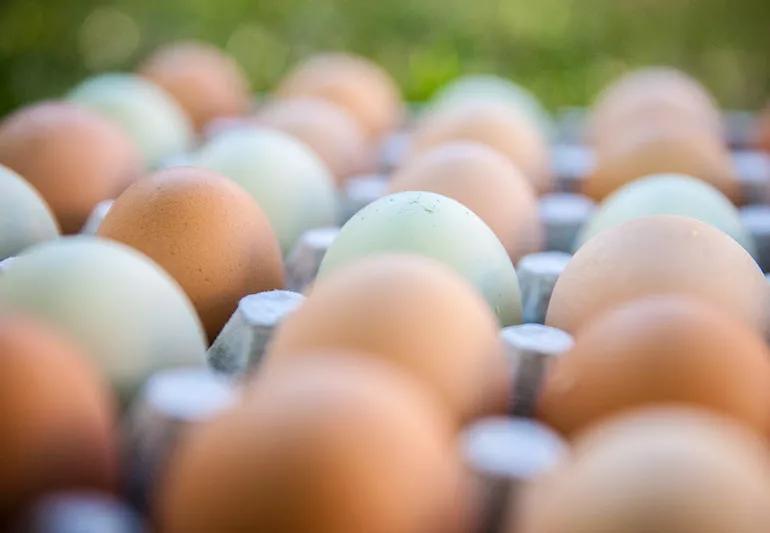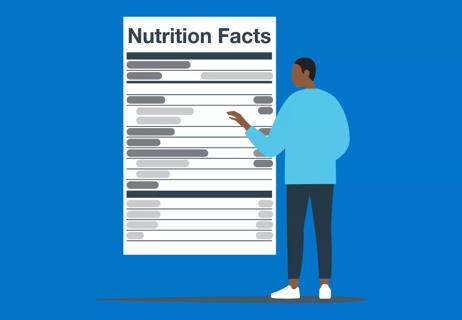Advertisement
Pasture-raised and organic eggs have additional nutritional benefits

Egg cartons are some of the most meticulously labeled items in a grocery store. One quick glance and you’ll see a number of (seemingly) interchangeable terms like “free-range,” “free-roaming,” “pasture-raised,” “farm fresh” and more. So how do you make sure you’re buying the best product? And what do each of those terms actually mean?
Advertisement
Cleveland Clinic is a non-profit academic medical center. Advertising on our site helps support our mission. We do not endorse non-Cleveland Clinic products or services. Policy
To understand the labeling process, it’s important to wrap your head around how eggs are handled before they ever reach the grocery store. Registered dietitian Susan Campbell, RD, walks us through the U.S. egg labeling system and answers the question: Which eggs are best for you?
Eggs are handled much differently in the U.S. than in most other countries of the world.
In the U.S., eggs are washed and then refrigerated from the time they leave the farm until the time they’re bought. This process of refrigeration, along with many other safety measures, is an effort to stop the spread of Salmonella — one of the most common types of food poisoning. If you stop refrigerating your eggs once you’ve started, your eggs will begin to sweat, causing mold and bacteria to grow inside the egg. But in many other countries, including most of Europe, eggs don’t have to be refrigerated because egg-laying hens are vaccinated against Salmonella. Both methods to stop the spread of Salmonella work well.
Over time, as egg production has increased, the U.S. Department of Agriculture (USDA) has developed a complex system of regulations to ensure eggs are processed and handled in a healthy manner and labeled correctly before they hit the market.
Depending on where you live and your state laws, labeling requirements may vary across state lines. All labels require the following:
Any other claims that are made (like saying your eggs are “cage-free” or “farm fresh”) are voluntary labels. And of the voluntary labels, only some of them are regulated by the USDA after they meet specific requirements.
For example, to claim eggs are local or locally produced, the eggs must originate from less than 400 miles from the processing facility or within the state the eggs originated from and were processed in. To claim eggs arevegetarian fed, the producer, packer or distributor must maintain documentation that no animal byproducts were used to feed egg-laying hens. But if someone claims their eggs are grass-fed, there’s no legal USDA definition of what that means.
In many cases, these voluntary labels are certified by third-party animal welfare advocacy groups like Global Animal Partnership or Certified Humane. If you’re looking for more responsibly farmed products, these animal welfare labels are the ones you want to look out for.
Advertisement
“There are a lot of categories for eggs, and a lot of them have to do with animal welfare,” says Campbell. “Nutritionally speaking, there are some small differences between them.”
Here are some of the most common labels you need to know.
The USDA defines cage-free eggs as eggs laid by hens that are able to roam vertically and horizontally in indoor spaces while having access to fresh food and water. The trend toward using cage-free environments rather than the longtime standard of battery cages in the U.S. has been increasing sharply over the last several years. As of July 2022, 105 million cage-free hens have produced about 35% of the eggs on the market. That number has increased from about 10% in 2012, according to the USDA. Although this method of egg production is accepted as more humane, some cage-free farms may restrict outdoor grazing.
“If they’re cage-free, they move about more freely but they don’t go outside,” says Campbell. “So, they might not get as great of nutrition — they’re kept inside and don’t get as much fresh air.”
These kinds of eggs have a bit more freedom. The USDA definition for free-range follows all the same rules as cage-free eggs, but with the added requirement of having “continuous access to outdoors during their laying cycle.” Those requirements don’t define how much time hens are permitted to spend outside, leaving that ruling up to interpretation. However, animal welfare groups like Certified Humane define free-range as having at least six hours of outdoor access each day with a minimum of 2 square feet of outdoor space per bird.
This term isn’t regulated by the USDA. However, if it comes with a third-party animal welfare certification seal, it comes with more defined regulations than free-range eggs. Certified Humane and American Humane Certified both require pasture-raised egg-laying hens to have at least 108 square feet of pasture with live vegetation, and for those fields to be rotated so that fresh vegetation is always available. Having access to the outside year-round means they must also have a barn they can access when needing protection from predators.
Advertisement
“Pasture-raised and organic eggs often have darker, yellower yolk and are found to have less cholesterol,” explains Campbell. “This might be because of continuous access to live vegetation and because they have more omega-3 fatty acids.”
This USDA-defined term has an extra set of requirements in addition to what’s typically required for pasture-raised eggs. Organic egg-laying hens must be provided with 100% organic feed without the use of pesticides, herbicides or fertilizers. They must also be able to graze outside for at least 120 days a year.
This term is misleading. The USDA has banned the use of hormones, so all eggs without this label are already hormone-free.
The color of your eggs is determined by the pigment of the hen that lays them. White hens produce white eggs, and reddish-brown hens produce — you guessed it — brown eggs. No matter what color of eggs you choose, they have the same relative nutritional benefits.
There are three USDA-approved grademark shields for eggs, and each grade is defined by the eggs’ appearance, outer shells and the quality of their yolks:
“Some chefs prefer the thicker grades when they’re making a fried egg, and prefer the thinner grades when making omelets or batters,” notes Campbell.
The best choice of eggs is up to your own personal preference. If you want to purchase eggs that have an animal welfare certification, those eggs will likely be of higher grades from egg-laying hens that are pasture-raised and/or organic. Those kinds of eggs, which have heartier shells and richer yolks, do tend to be more expensive. Seeing as how eggs are a relatively inexpensive source of protein, it’s understandable why you may reach for other cartons instead.
Advertisement
Learn more about our editorial process.
Advertisement

What’s on your plate can either help power you through your day or put you in nap mode

Information on serving size, calories and nutrients can help you make healthy choices

Often labeled as ‘diabetes-friendly’ or ‘calorie-free,’ these sugar substitutes warrant caution

Repeating your meals can help simplify meal planning and counting calories, but it could also lead to boredom and nutritional deficiencies

Making certain food and lifestyle choices can help keep your battery full

The general rule is 0.8 to 1 gram of protein per kilogram of body weight — but that may not be right for you, and it’s important to determine what’s right for you

Fiber-rich shirataki noodles may improve blood sugar, aid in digestion and help with weight loss

Reducing inflammation is key when you’re in a flare-up, but so is having a preventive nutritional plan in place when you’re not

Focus on your body’s metabolic set point by eating healthy foods, making exercise a part of your routine and reducing stress

PFAS chemicals may make life easier — but they aren’t always so easy on the human body

While there’s little risk in trying this hair care treatment, there isn’t much science to back up the claims